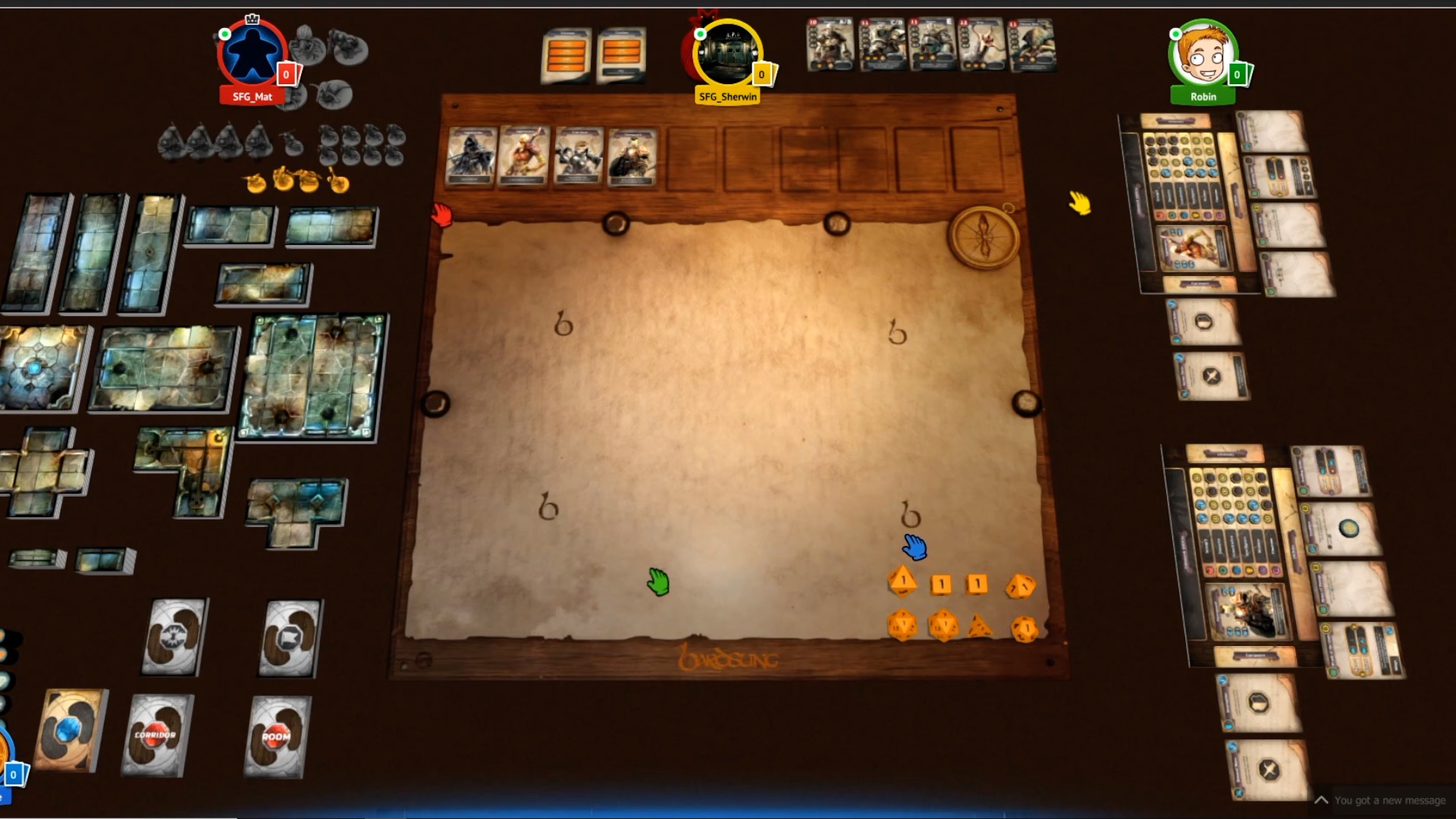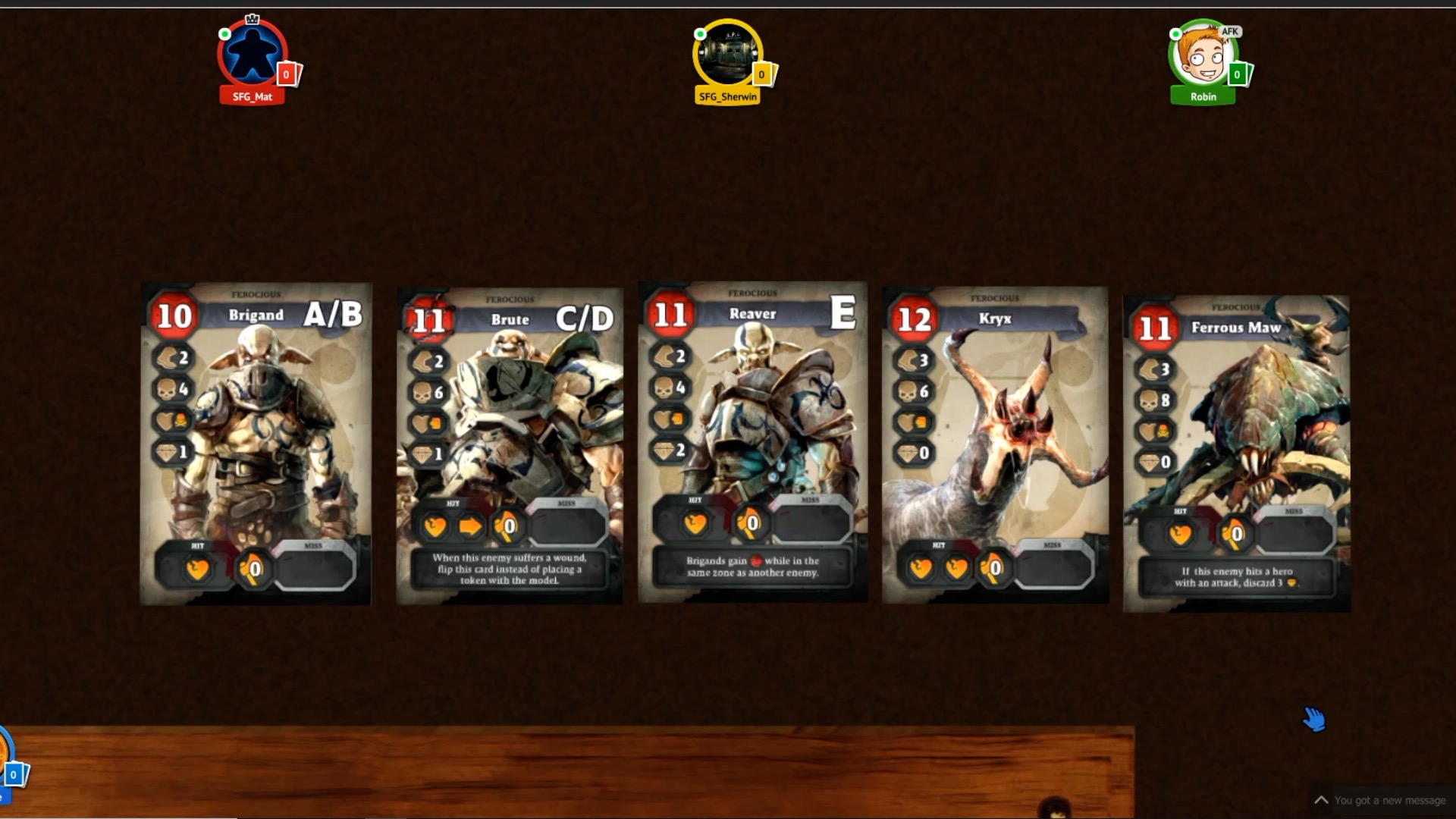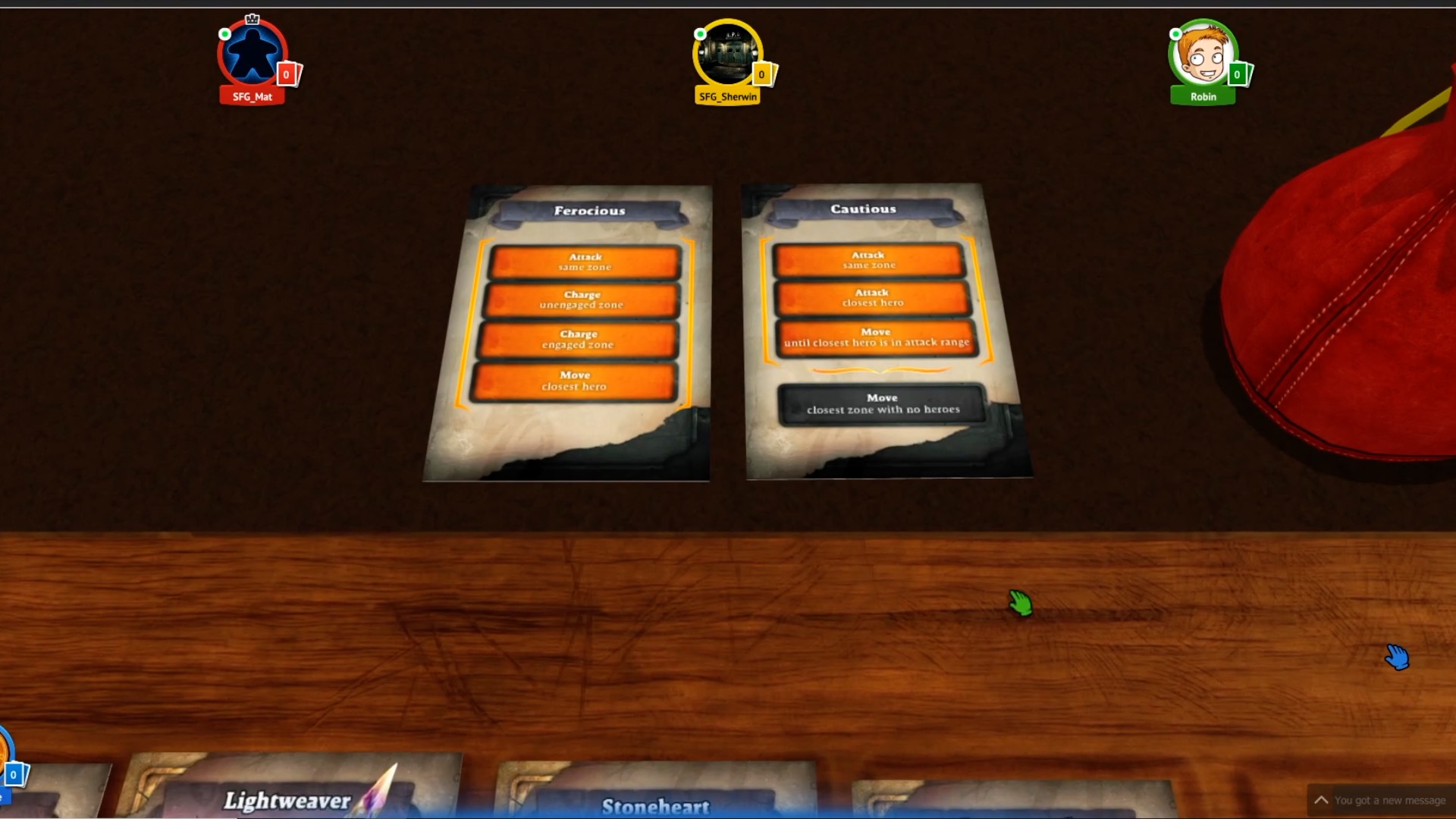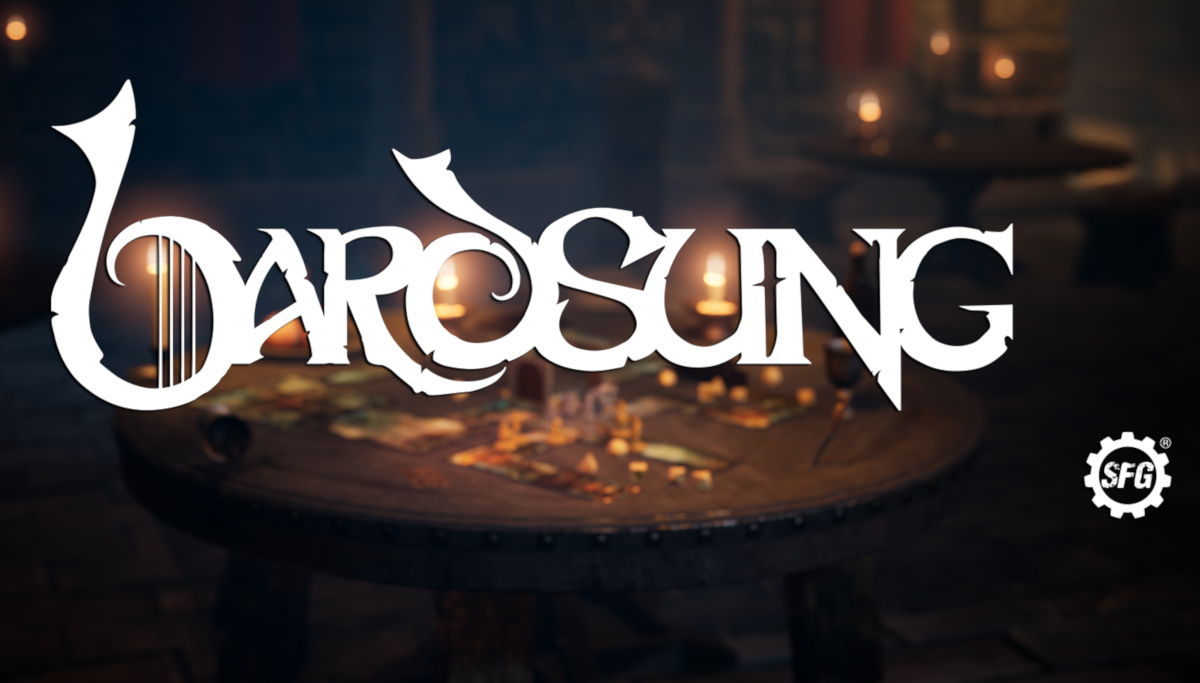Steamforged Games is back with another Kickstarter. This time the makers of the Resident Evil 2 and Dark Souls boardgames are back (again) with a game entirely of their own making. Prepare to delve deep into treasure-filled dungeons and have songs written about your exploits in Bardsung.
Check out the Bardsung Kickstater page, here!
Normally for these sorts of reviews, I’d have had a look at the components and played a few games to properly get a feel for the game. Due to COVID-19, this hasn’t been possible. What I have had is a digital playthrough on Tabletopia with Mat Hart and Sherwin Matthews from Steamforged games. It’s evident from talking to them that they’re passionate about this game and many hours of work have been contributed to its genesis.
This review is based on a single playthrough, so it’s more than possible I have misremembered some of the details. Any mistakes in this review are mine, not Steamforged Games’. All images shown are prototype images.
New to Kickstarter? Check out our crowdfunding primer.
What is Bardsung?
In essence, Bardsung is a dungeon crawler. It’s a series of linked quests for between 1 and 5 players. Dungeons are created on the fly with monsters and treasure generated randomly in each game. Players have to traverse from one side of the Bardsung player mat to the other, collecting treasure as they go. A single playing session is slated to take between 30 mins to an hour, depending on the type of quest attempted.
If you want to check out Steamforged’s detailed blog posts about how Bardsung works you can do so, here.
When I spoke to the Steamforged team, I was interested as a parent and GeekDad writer, in just how easily this game could be played. If I want to play it with my children, will they lose interest? If I want to play after they have gone to bed, will I still be setting up at 10 pm, and constantly agonizing over which weapon upgrade to take or working out which dice modifiers apply, meaning I go to bed after midnight?
The Steamforged blog posts talk about the high level of flexibility and customization in the game, which I’m all for, but as I grow older, I often find they can unnecessarily complicate things. I was interested to see if Bardsung could provide this flexibility without being impossible to play for time-poor parents.

What’s in the Bardsung box.
As previously stated, I’ve only seen digital components so far, but slated to be in the standard Bardsung box are the following:
-
66 high-quality miniatures:
-
5 x heroes
-
-
-
1 x Kickstarter exclusive hero
-
52 x enemies
-
5 x wandering monsters
-
4 x bosses: Including a demon model that stands over 6 inches tall to the top of the wings, with an 8.3-inch wingspan!
-
- Rulebook
- Adventure book
- 1 paper playmat
- Dice
- 795 cards (across 11 decks)
- Tokens
- 29 dungeon tiles
- 5 player dashboards
-
Plus all unlocked stretch goals (including the Kickstarter exclusive Gladestrider hero, which has already been unlocked).
The baseline Kickstarter price will be $99, but there will inevitably be some add-on sales. For example, I expect you’ll be able to upgrade the paper play mat to a neoprene one.

An Overview of Bardsung gameplay.
In Bardsung you are setting out on a campaign made up of connected adventures. These adventures consist of a number of dungeon delves. There are plans to flesh out the Bardsung world into wilderness settings and into a full RPG experience, but for the moment the game is more akin to a physical “Choose Your Own Adventure,” set in a dungeon.
I have seen a prototype adventure map. These maps see players trying to traverse from point A (the beginning) to point B (where the Boss lives). There are multiple routes between A and B, with each stop en-route being a single dungeon exploration (game session). Each time you want to start a session, you pick an available spot on the map and play out the associated delve.
The Bardsung design philosophy.
The designers of Bardsung are very keen that it passes the “Christmas Day” test. They’re very aware that board games are under intense pressure to compete with X-Boxes, Playstations, and Netflix. They want their games to be playable as quickly as possible. For this, they devised the Christmas Day test. After unwrapping the game on Christmas Day, can you get it onto the table and play it, without the other presents or festivities getting in the way? Often a tall order.
In order to do this, Bardsung will be organized in trays within the box, so you can pull out “Game One” and everything will be prebuilt for you to dive straight in. The lead in to the game will introduce new rules as you need them. Each rule has been designed to be simple to implement, on its own, but with the idea that players can discover how certain rules interact with one another to unlock potent and powerful effects on the tabletop.
For example, from my playing experience, combat is very simple (roll a D20 add your stat and weapon bonus), and you could do that all day, but each character on the board has a special ability, which can turn the tide of battle. The game then becomes about using each character’s skills to work together to create the best outcome for the party as a whole.
The team were also keen to ensure that whilst classic tropes are reflected in the game, they’re not implemented in a stereotypical fashion. They don’t want the fighters to be up front rolling all the dice (having all the fun) whilst the cleric and mage sit back waiting until they’re needed. Firstly, everybody has a role throughout combat; working together is the best way to solve the problem. Secondly, multi-classing is not only allowed, it’s positively encouraged. If you want to be a “tank-mage,” it’s entirely possible to do that.
I haven’t had much opportunity to dive into the game’s storytelling elements, but Steamforged Games are clearly taking it very seriously. Adventure contributors include Ian Livingstone, Rhianna Pratchett, and Sara Thompson. This triumvirate alone makes a very strong case for backing the project.

A Basic Game of Bardsung.
The first intriguing thing about a game of Bardsung is the way you set it up. The game comes with a rectangular playmat and all play sessions take place on it. This marks out the fullest possible extent of your dungeon. When you pick your game from the adventure map, it will be either short, long, or corner. In each case, you play from side to side. So a quick game will be playing from long side to long side, next will be short side to short side, and, as anybody who knows their Pythagoras will tell you, corner to corner is the longest of all. Game times should break down roughly into 30mins, 45mins, 1hr, depending on which type of game you’re playing.
Exploration is done via decks of cards. These are generated at the start of a session, using rules given by the session type described on the adventure map (for example, some sessions are designed to be trap heavy). Each time a character uses their turn to explore, a new tile is placed on the play mat. If you are exploring from a room tile, you draw from the corridor deck, if you explore from a corridor, you draw from the room deck, ensuring you get a balanced dungeon interior design. Room tiles have doorways marked on them and you have to arrange the tiles in a logical fashion, but otherwise, orientation is up to the players. Some tiles are simple doorways, others will tell you to add a door too.
Another interesting feature of the Bardsung playmat are the 4 symbols emblazoned on it. In a game, between 1 and 4 of these will have a treasure card placed on them (face down) if you can then make your dungeon tiles overlap one of these cards, you find the treasure. This means you may want to take a detour in search of precious loot.

As you explore the dungeon, you will inevitably find monsters, which you’ll have to fight. If ANY of the characters die it’s game over. The session finishes. You may not have failed, however. Bardsung has a fail-forward mechanic, which means as long as you have found some loot (how much is dependent on the adventure instructions) you will score at least a partial success, which means you move to a new point on the adventure map, should you wish.
Another couple of interesting aspects to the game, though I had little direct experience of them in my playtest session, are the continually running events. If you set off a trap that causes a chamber to flood, the water keeps flowing even after you leave the room. If for some reason you have to return the way you came, you may find your retreat cut off.
Similarly, every turn, players must make a wandering monster check. If one appears, it will start on the first dungeon square, but then each turn will follow you through the dungeon. These are pretty tough to beat and don’t give you any treasure, so are probably best avoided! But this dungeon has lots of nasty surprises, not to mention dead ends, so if you do find yourself retracing your steps (perhaps you just triggered a water trap), you’d better be prepared in case it’s behind you. (Perhaps the Christmas Test also involves invoking the great British pantomime tradition!)

Combat in Bardsung.
There are a few simple mechanics that will be familiar to players of D&D, and these are implemented in Bardsung in a similar fashion.
- Initiative. In each turn of the game, an initiative order is created. This is done using cards, much as in Blackstone Fortress. A card for each type of creature and character are shuffled together and this then creates the initiative track for that turn. There are powers and skills that can affect the order, but I didn’t really get to see many of these in action. It is possible to pin a character to the track, so they don’t get moved next turn. Handy if you can get the best fighter to the top of the tree!
- Advantage/Disadvantage. Possibly the best addition to the D&D ruleset since Gary Gygax said, “we need more dice,” Steamforged are fully taking (ahem) advantage of it.
- Inspiration. Not, like in D&D, something everybody forgets about, in Bardsung inspiration is a vital component to success. It’s something every player will be holding out for as it spending inspiration unlocks extra abilities.
Combat in the game is both simple and nuanced. It’s also definitely a group activity!
The inspiration mechanic is vital to combat success. The players have access to a pool of up to 4 inspiration tokens at any one time. They can be spent to carry out special abilities or extra attacks, but each spend is a one time only thing, so choose wisely. Each character has their own way of generating inspiration which might be “take out a monster” or “push a monster into an empty zone,” and your combat decisions may sometimes be based on gaining inspiration as well as taking monsters down. You can also gain inspiration by rolling natural 20s (a critical!) or 1s (a fumble!).
When it’s your turn to hit, you roll a D20, add your stat bonus, (say Strength for a fighter) and any weapon bonus you may have, aiming to roll over the number on the relevant monster card. (The initiative cards have all the monsters important stats on.) At early levels, you generally only have one basic attack, so you always know what your base roll is. When it’s your time to defend, it’s exactly the same, except you use your defense stat. For each type of monster, the attack/defend number is the same, making it really easy for you to remember what you need to score. E.g., if you need 10 or more to hit, you’ll need 10 or more to defend too.
Failure to defend means you take a wound. Take too many wounds and you die.
Wounding monsters is a little more tricky. Characters roll a damage dice. If you get above a certain number (dependent on monster toughness) you score a critical hit, below that, just a scratch. Broadly speaking, a critical hit will take out a monster in one hit (the weaker ones anyway) but you’ll need a couple of scratches to do the same. Some monsters get their cards flipped, which can change their stats (i.e., you’ve made them angry) and can change how they interact on the board.
I did find this a little confusing. Each initiative card may pertain to several monsters but there is still only one card per monster type. If the card flips, all monsters are treated in the same way. When one monster is killed the card is flipped back to its original side, meaning all the remaining monsters of that type revert back to their original state. It’s a little counter-intuitive.

Monster A.I.
Games like Bardsung live and die by their monster A.I. I remember when I played GW’s Silver Tower that I was ultimately put off by the arbitrary nature of it all. There was no imperative to do what we were doing. The procedural dungeon building and overarching adventure elements help mitigate this in Bardsung, but if the monsters don’t do interesting things, the game is going to fall flat.
One combat, albeit an epic one, is not the easiest way to determine how great the Monster A.I. is. One thing I did learn, is that it’s chaotic enough not to fall foul of the problem a lot of co-op dungeon crawlers have. Each fight will not turn into “sit down, crunch the numbers, do the stuff, win.” Decisions within the dungeon and specifically within combat are meaningful.
In a standard RPG or indeed any game really, it’s hard to elevate combat beyond a planning phase and then a long time of everybody rolling dice until one side is dead. In Bardsung the board tiles are divided into zones (a little like the ones in Wildlands or are described in AoS: Soulbound), and which zone a fighter is in matters. I honestly don’t think I’ve played a game where combat felt such an organic collaborative thing. You have to move; you might need to back up a fighter, you may need to back off to draw away monsters to give your comrades some breathing space. It may be you need to push an enemy into an empty square to allow another party member to use a special ability to do something memorable (and probably quite painful) to them.
Combat in this game is literally the stuff legends are meant to be made of, and it really does feel like a cinematic, no, bardic, experience.
Monsters don’t all fight the same way. They won’t stand around waiting to be killed; they might go to an occupied fighter to take the battle to them or they might pile in on somebody who is already outnumbered. If that wasn’t enough, the group of hobgoblins you fought in this room, will be different from the group you fought in the previous room. Each combat has an extra card dealt to it, that will change the battle slightly. In our game, the already horrible group of monsters we encountered was made worse, because we were ambushed from behind at the same time. These cards have all manner of things on them, I imagine. One group might have better armor, another might have poisoned weapons. Whatever card is drawn, it ensures that fights against similar enemies pose different difficulties for the players to overcome.

The TL;DR:
Bardsung is an ambitious project. One that aims to balance the flexibility and scope of an RPG and the accessibility of a boardgame. Lots of games have tried to do this, not least of all Warhammer Quest and Descent. It’s understandably a popular arena. RPGs take time and planning and legacy games are hugely attractive. Bardsung aims to give everybody that hit of RPG action, without one person having to do a lot of legwork. It seems to work just fine.
I haven’t had much opportunity to study the storytelling elements of Bardsung but even as a one-off session, there is much to sing about. The battles are epic, the dungeons atmospheric. The character customization options are there for those who like that sort of thing, but the list of suggested presets for each hero will work just fine for people who aren’t bothered by that side of things. If you just want to pack the game away and forget about it between sessions, that’s fine. If you want to create an epic story and a character unique to you that’s fine too. You won’t be penalized for doing either. Our playthrough session barely touched the character side of things. We used a fraction of the information stored on the player cards.
The game is designed not to have optimum character builds. I’m sure there are some devastating combos, but the Bardsung is designed to be narrative-driven than fall into the number-crunching domain of power gamers. The combat system rewards action and decisiveness. You can still succeed even in failure, so you shouldn’t feel compelled to calculate every last piece of efficiency in every encounter. You can still find success, even if you charge into every fight with your bottom painted blue.
I haven’t seen any physical models from the game, but as you can see from the photos, the 3D renders of the potential sculpts are super-impressive.
I spent an excellent couple of hours with my introduction to Bardsung. It’s clear the creative team behind it is passionate about their project. They have a huge number of ideas about extending and expanding the Bardsung universe. If it gets player backing, this is a system that can run and run. I’m sure this Kickstarter will fulfill its goals in hours, if not minutes. If you want to check out all the action, you can do so on the Bardsung Kickstarter page.

![]() To subscribe to GeekDad’s tabletop gaming coverage, please copy this link and add it to your RSS reader.
To subscribe to GeekDad’s tabletop gaming coverage, please copy this link and add it to your RSS reader.
Click here to see all our tabletop game reviews.
Disclosure: GeekDad received a copy of this game for review purposes.





